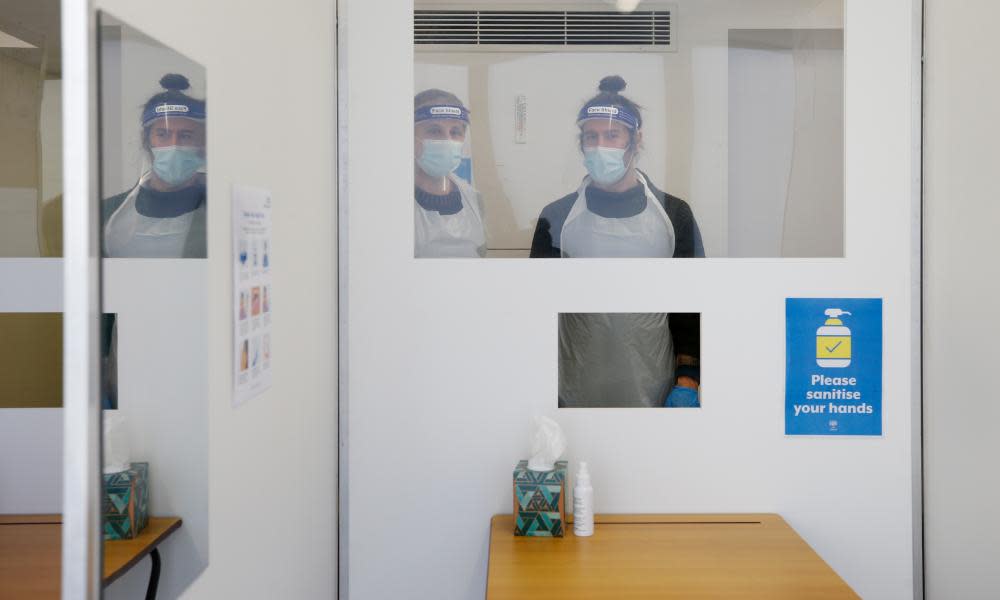Coronavirus variant found in India may spread faster than type detected in Kent

Evidence is growing that a troubling variant of the coronavirus discovered in India is more transmissible than the variant first detected in Kent and which fuelled the UK’s second wave of infections and spread around the world.
It comes amid reports that Public Health England figures to be released on Thursday could show that the number of cases linked to the variant have tripled in a week. The i newspaper reported that scientists on the Sage advisory committee would hold an urgent meeting on Thursday to discuss the threat.
Meanwhile, researchers at Imperial College London analysed more than 127,000 swabs taken between 15 April and 3 May in England, and found that while coronavirus case rates had halved compared with March, the variant of concern known as B.1.617.2 and found in India could be spreading faster than the “Kent variant”, at least in London.
In the latest findings from the React study, the Imperial team recorded 115 positive tests and identified the variant for 26 of them. The majority, 24 cases, belonged to the variant detected in Kent at first, the B.1.1.7. But out of the three positive tests sequenced in London, two were the variant of concern from India. Neither of the people who tested positive for the variant reported travelling in the previous two weeks.
The numbers are very small, but have raised further concerns that the new variant is able to spread more swiftly than B.1.1.7. In a preprint released on Thursday, the scientists write: “The fact that we observed B.1.617.2 at a similar, or higher, frequency to the long-established B.1.1.7 lineage in London suggests that B.1.617.2 may be more transmissible than B.1.1.7 in the populations where the two viruses are currently circulating.”
Prof Paul Elliott, director of the React programme at Imperial, said: “It seems to be circulating, at least in London, and it is at least as transmissible as the Kent variant. We need to understand more about it.”
The findings come as Prof Tom Wenseleers, at the University of Leuven, who worked closely with UK scientists on the spread of B.1.1.7, said the Indian variant of concern could be 60% more transmissible than the former.
“Based on the rapid rise of B.1.617.2 in both India, among cases exported from India, and among cases without a travel history in the UK, and the fact that in all these places B.1.617.2 outcompetes the Kent variant in terms of relative representation, I would conclude that it is likely that this Indian variant of concern does have a growth advantage over the Kent variant,” he said.
It is unclear what might be driving any advantage, but the variant might be more contagious, have a longer infectious period, or partly evade immune defences, Wenseleers added. It will take more detailed epidemiological models and better data to confirm exactly how transmissible the Indian variant is.
Public Health England designated B.1.617.2 a “variant of concern” on Friday and acknowledged that it was at least as transmissible as B.1.1.7 in the UK.
Scientists have warned that the sharp rise in cases of the “India variant” could jeopardise the country’s roadmap out of lockdown. Genomic surveillance data from Wellcome’s Sanger Institute, which excludes swabs from recent travellers and surge testing, suggests that about 6% of coronavirus sequenced in England in the month to 24 April belong to B.1.617.2.
On Wednesday, Boris Johnson said that the government intended, on 21 June, to lift guidance on working from home, the earliest date at which nearly all restrictions could be lifted as step four in the roadmap. He told MPs: “We’ll wait until we’re able to say that with more clarity a bit later on because we must be guided by what’s happening with the pandemic.”
Despite concerns over the B.1.617.2 variant, the React study findings are encouraging. Across England, prevalence of the virus has fallen to about 1 in 1,000 people, a level not seen since August last year; however, case rates are twice as high in participants of an Asian heritage compared with white people.
According to the study, the vaccine programme has weakened the link between infections and hospitalisations and deaths. Meanwhile the epidemic is shrinking in all regions, with the exception of south-east England, where there is a hint that cases have started to rise. “We need to keep a close watching brief to see if prevalence starts increasing further in this region and if so whether that is localised to specific areas,” Elliott said.

 Yahoo News
Yahoo News 
